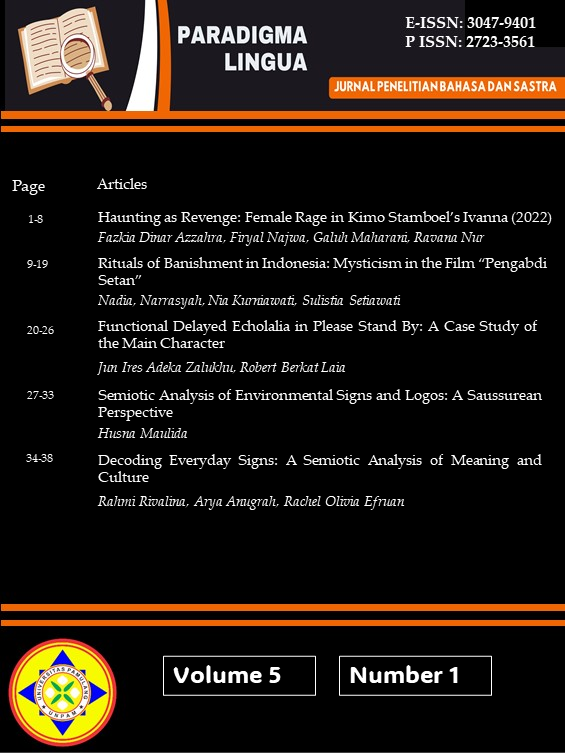Functional Delayed Echolalia in Please Stand By: A Case Study of the Main Character
Keywords:
Functional delayed echolalia, Autism, Please stand by movieAbstract
This research analyzes the functional delayed echolalia of Wendy, the main character in the film Please Stand By (2017), using Prizant and Rydell’s framework. Echolalia, the repetition of phrases or sentences, serves as a key communication tool for individuals with autism, aiding social interaction and emotional regulation. Employing a descriptive qualitative method, the study identifies and categorizes echolalic phrases from the film. The findings reveal seven types of interactive delayed echolalia (turn-taking, verbal completion, providing information, protest, request, affirmation, and directive) and four types of non-interactive delayed echolalia (non-focused, situational association, self-directive, and rehearsal). These results highlight echolalia’s functionality in supporting autistic individuals' communication and self-regulation. By analyzing how echolalia is portrayed in a media context, this study contributes to a deeper understanding of autism communication and promotes greater awareness of its significance in fostering social inclusion.
References
Abrams, M. H. (2004). The mirror and the lamp. In Essays in Criticism (Vol. 54, Issue 3, pp. 260–282). https://doi.org/10.1093/eic/54.3.260
Alvesson, M., & Karreman, D. (2011). Qualitative Research and Theory Development. www.sagepublications.com
Filipova, S., Jovchevski, V. G., & Shoster, D. (2023). The Role of Delayed Echolalia Produced by Children with Autism Spectrum Disorder. International Journal of Research Publication and Reviews, 4(7), 1890–1895. https://doi.org/10.55248/gengpi.4.723.49127
Fitrianingsih. (2018). a Psycholinguistic Analysis of Functional Delayed Echolaliaand Autistic Responses in Barry Levinson’S Rainmanmovie. English Language & Literature Journal, 7(4), 420–431.
Frith, U. (2008). Autism: A Very Short Introduction. Very Short Introductions, 129. https://play.google.com/store/books/details?id=j40SDAAAQBAJ%0Ahttp://veryshortintroductions.com/view/10.1093/actrade/9780199207565.001.0001/actrade-9780199207565%0Ahttp://dx.doi.org/10.1093/actrade/9780199207565.001.0001
Golysheva, M. D. (2019). A Review on Echolalia in Childhood Autism. 333(Hssnpp), 200–204. https://doi.org/10.2991/hssnpp-19.2019.37
Humaira, Q. N., & Sudarwati, E. (2021). Functional Delayed Echolalia: Insights From a Movie. Language Literacy: Journal of Linguistics, Literature, and Language Teaching, 5(2), 340–355. https://doi.org/10.30743/ll.v5i2.4430
Prizant, B. M. & Rydell, P. J. (1984). Prizant (1984) analysis of delayed echolalia in children.pdf. In American Speech-Language Hearing Association (Vol. 27, Issue 2,
Downloads
Published
Issue
Section
License
Authors who publish with this journal agree to the following terms:
- Authors retain copyright and grant the journal right of first publication with the work simultaneously licensed under a Creative Commons Attribution License that allows others to share the work with an acknowledgement of the work's authorship and initial publication in this journal.
- Authors are able to enter into separate, additional contractual arrangements for the non-exclusive distribution of the journal's published version of the work (e.g., post it to an institutional repository or publish it in a book), with an acknowledgement of its initial publication in this journal.
- Authors are permitted and encouraged to post their work online (e.g., in institutional repositories or on their website) prior to and during the submission process, as it can lead to productive exchanges, as well as earlier and greater citation of published work (See The Effect of Open Access).
Paradigma Lingua have CC-BY-SA or an equivalent license as the optimal license for the publication, distribution, use, and reuse of scholarly work.
In developing strategy and setting priorities, Paradigma Lingua recognize that free access is better than priced access, libre access is better than free access, and libre under CC-BY-SA or the equivalent is better than libre under more restrictive open licenses. We should achieve what we can when we can. We should not delay achieving free in order to achieve libre, and we should not stop with free when we can achieve libre.


